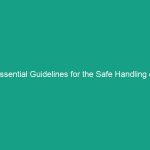Introduction
Good morning team! Today, we want to discuss a very important topic that directly affects our Safety and productivity on the job site: Essential Skid Steer Safety Guidelines. As many of you know, skid steers are versatile machines that can help us complete various tasks efficiently. However, operating these machines comes with its own set of risks. Understanding these risks and following proper Safety guidelines is vital for our well-being and success on the job.
So why are we focusing on skid steer safety today? Skid steers are involved in a significant number of workplace accidents every year. By being proactive and informed, we can avoid these critical risks and ensure a safer working Environment for everyone.
Understanding Essential Skid Steer Safety Guidelines
The term Essential Skid Steer Safety Guidelines refers to a comprehensive set of practices designed to ensure the safe Operation of skid steer loaders. These guidelines are crucial for minimizing accidents and injuries while improving operational efficiency.
Many employees believe that simply having experience with machinery is enough to operate a skid steer safely. However, this belief can lead to dangerous situations. Safety guidelines are based on Best Practices that consider not only the machine’s capabilities but also the environment and the operators’ well-being.
Key Hazards, Risks, and Safety Considerations
When operating a skid steer, several Hazards can arise, including:
- Tip-Overs: Skid steers can be top-heavy, making them prone to tipping, especially on uneven ground.
- Collisions: Poor visibility and speed can lead to collisions with other workers or obstacles.
- Struck-By Hazards: Workers on foot can be struck by the skid steer or its attachments if proper Precautions aren’t taken.
- Entanglement: Loose clothing or long hair can become entangled in moving parts of the machine.
Ignoring these safety protocols can lead to severe injuries or fatalities. For instance, tip-overs can result in operators being pinned or crushed, which can have devastating outcomes for both the individual and the team.
Best Practices, Procedures, & Actionable Advice
To mitigate the risks associated with skid steers, follow these essential safety guidelines:
1. Pre-Operation Checks
Before using a skid steer, conduct a thorough pre-operation inspection. This should include:
- Checking fluid levels (oil, hydraulic fluid, and fuel).
- Inspecting tires for damage and proper inflation.
- Ensuring that all safety equipment is in place and functional.
2. Proper Training
Only trained and authorized personnel should operate skid steers. Make sure you:
- Complete all required training programs.
- Understand the specific features and controls of the skid steer you will be using.
3. Use Seatbelts
Always wear your seatbelt while operating a skid steer. This simple action can prevent ejection during a tip-over.
4. Maintain Visibility
Be aware of your surroundings. Ensure that you have a clear line of sight and use a spotter when necessary, especially in crowded areas.
5. Avoid Overloading
Never exceed the manufacturer’s recommended load limits. Overloading can affect the machine’s stability and increase the risk of tip-overs.
6. Safe Operating Practices
When operating the skid steer, keep the following in mind:
- Always keep the bucket low to the ground when traveling.
- Use smooth, controlled movements to prevent sudden shifts in weight.
- Be cautious when turning or operating on slopes.
Real-World Incident: Learning from Experience
Consider the case of a worker who was seriously injured when their skid steer tipped over while turning on a slope. They were not wearing a seatbelt, which led to severe injuries. This incident highlights the importance of following proper Procedures and using safety equipment.
Regulations, Standards, and Compliance
Adhering to safety Regulations is not just a best practice; it’s a legal requirement. OSHA (Occupational Safety and Health Administration) sets forth guidelines that all employers must follow regarding heavy equipment operation, including skid steers. Key regulations include:
- Proper training and certification of operators.
- Regular Maintenance checks on equipment.
- Implementation of a Hazard Communication program.
Compliance with these regulations is essential for protecting employees and reducing liability for the company. Remember, safety is everyone’s responsibility!
Employee Engagement & Discussion
Now, let’s open the floor for discussion. What safety challenges have you encountered related to skid steer operations? Are there specific scenarios where you felt uncertain about the safety guidelines? Sharing experiences can help us all learn and improve our practices.
Conclusion & Key Takeaways
In conclusion, understanding and applying Essential Skid Steer Safety Guidelines is crucial for maintaining a safe work environment. Remember to:
- Perform thorough pre-operation checks.
- Ensure proper training and certification.
- Always use seatbelts and follow safe operating practices.
By prioritizing safety, we not only protect ourselves but also our coworkers and the integrity of our worksite. Thank you all for your attention and commitment to making safety a priority in our daily operations. Let’s work together to avoid critical risks today!


